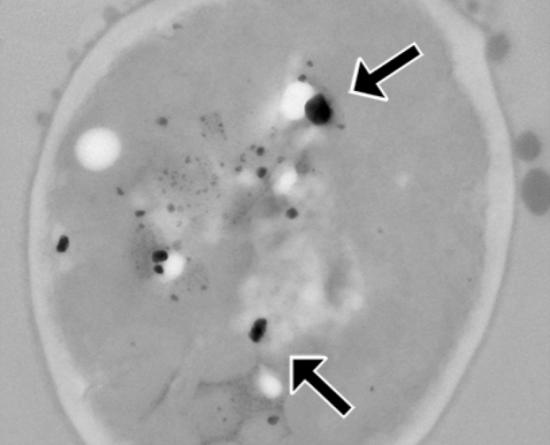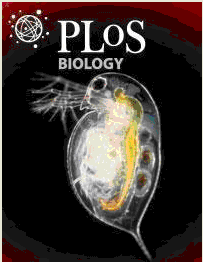导读:哈佛大学的科学家对酵母菌进行基因改造,使其可能在线粒体中储存铁,并且表现出磁力……

基因改造过的酵母对磁力有反应,箭头所指处为细胞中的铁(图:Harvard Medical School)
哈佛大学威斯研究所的科学家对一种微生物进行基因改造,使其可以感应到磁场。这表明生物体是可以对磁力作出反应的,即便它们在正常情况下不会有此反应。
这项工作表明了在医学、工业及研究上的许多应用。例如,细胞对磁场的敏感可使它们就像小指南针一样朝一个方向排列。这就意味着它们可朝特定的方向移动以构建特定形状的组织。这项技术可用于在疾病中靶定治疗细胞,在磁共振成像中也能发挥有益作用。
某些种类的细菌能够感应到磁力是因为它们含有微小的铁或铁化合物。但是大多数的植物和动物并不如此,当它们的细胞接触到铁时,它们会试图将铁收集置于成为液泡的狭小中空的空间中。(许多的动物,包括人类的生存离不开铁,但是这种生存所需的铁都以各种不同的方式被代谢了。)
研究人员Pamela Silver和 Keiji Nishida在含有铁的培养基中培养普通的酵母。这些酵母细胞摄入铁并存放至液泡中。科学家然后将磁石置于培养平板之下,发现酵母具有微弱的磁性。
Nishida添加了一种叫做铁蛋白的蛋白质,这种蛋白质可结合铁并防止铁转变成有毒形态。他还对酵母进行基因改造,阻断其产生携带铁至细胞液泡中的蛋白质的能力。这就使得铁循环可以自由的贯穿酵母细胞,并使得细胞足够敏感,朝外部磁力迁移。
一个有意思的效果就是,经过基因改造的酵母在其线粒体中储存铁。基因改造过的酵母的磁性几乎是那些只补充铁但未进行基因改造的酵母的三倍。
研究人员还发现,酵母中的其他蛋白质—在其他动物包括人类中也有发现—可用于增加磁性。这些在其他动物中也存在的蛋白质意味着,只要进行小小的基因改造,其他的生物也可能成为活体磁条。

 Induction of Biogenic Magnetization and Redox Control by a Component of the Target of Rapamycin Complex 1 Signaling Pathway
Induction of Biogenic Magnetization and Redox Control by a Component of the Target of Rapamycin Complex 1 Signaling Pathway
Keiji Nishida, Pamela A. Silver
Most organisms are simply diamagnetic, while magnetotactic bacteria and migratory animals are among organisms that exploit magnetism. Biogenic magnetization not only is of fundamental interest, but also has industrial potential. However, the key factor(s) that enable biogenic magnetization in coordination with other cellular functions and metabolism remain unknown. To address the requirements for induction and the application of synthetic bio-magnetism, we explored the creation of magnetism in a simple model organism. Cell magnetization was first observed by attraction towards a magnet when normally diamagnetic yeast Saccharomyces cerevisiae were grown with ferric citrate. The magnetization was further enhanced by genetic modification of iron homeostasis and introduction of ferritin. The acquired magnetizable properties enabled the cells to be attracted to a magnet, and be trapped by a magnetic column. Superconducting quantum interference device (SQUID) magnetometry confirmed and quantitatively characterized the acquired paramagnetism. Electron microscopy and energy-dispersive X-ray spectroscopy showed electron-dense iron-containing aggregates within the magnetized cells. Magnetization-based screening of gene knockouts identified Tco89p, a component of TORC1 (Target of rapamycin complex 1), as important for magnetization; loss of TCO89 and treatment with rapamycin reduced magnetization in a TCO89-dependent manner. The TCO89 expression level positively correlated with magnetization, enabling inducible magnetization. Several carbon metabolism genes were also shown to affect magnetization. Redox mediators indicated that TCO89 alters the intracellular redox to an oxidized state in a dose-dependent manner. Taken together, we demonstrated that synthetic induction of magnetization is possible and that the key factors are local redox control through carbon metabolism and iron supply.
文献链接:https://www.plosbiology.org/article/info%3Adoi%2F10.1371%2Fjournal.pbio.1001269







